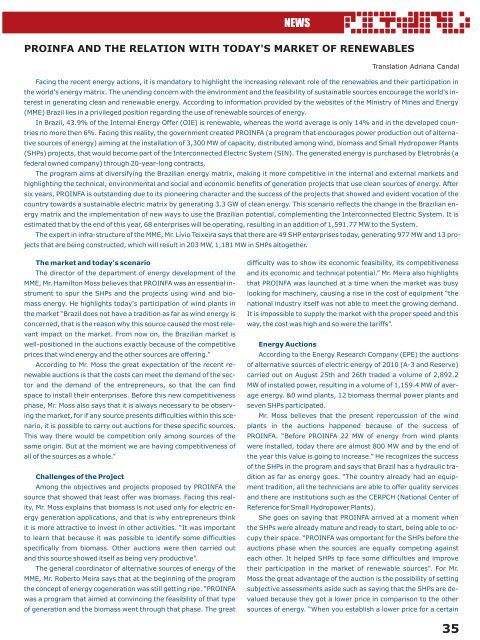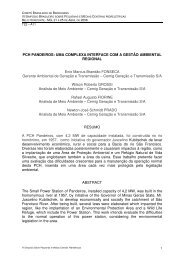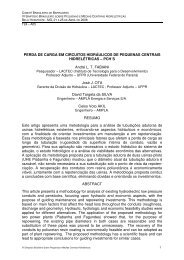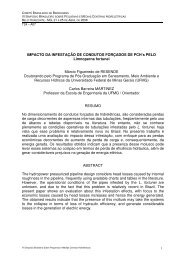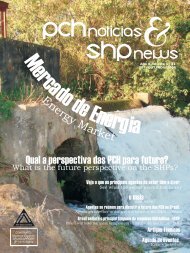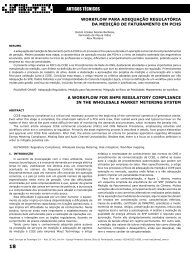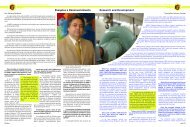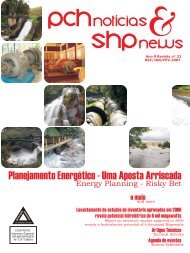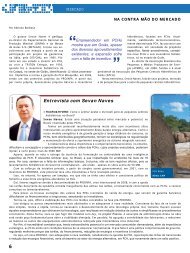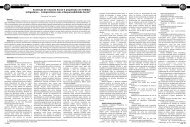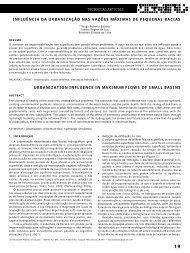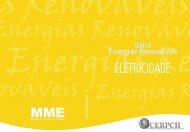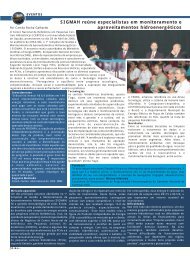03 - CERPCH - Unifei
03 - CERPCH - Unifei
03 - CERPCH - Unifei
Create successful ePaper yourself
Turn your PDF publications into a flip-book with our unique Google optimized e-Paper software.
NEWS<br />
PROINFA AND THE RELATION WITH TODAY'S MARKET OF RENEWABLES<br />
Translation Adriana Candal<br />
Facing the recent energy actions, it is mandatory to highlight the increasing relevant role of the renewables and their participation in<br />
the world's energy matrix. The unending concern with the environment and the feasibility of sustainable sources encourage the world's interest<br />
in generating clean and renewable energy. According to information provided by the websites of the Ministry of Mines and Energy<br />
(MME) Brazil lies in a privileged position regarding the use of renewable sources of energy.<br />
In Brazil, 43.9% of the Internal Energy Offer (OIE) is renewable, whereas the world average is only 14% and in the developed countries<br />
no more then 6%. Facing this reality, the government created PROINFA (a program that encourages power production out of alternative<br />
sources of energy) aiming at the installation of 3,300 MW of capacity, distributed among wind, biomass and Small Hydropower Plants<br />
(SHPs) projects, that would become part of the Interconnected Electric System (SIN). The generated energy is purchased by Eletrobrás (a<br />
federal owned company) through 20-year-long contracts.<br />
The program aims at diversifying the Brazilian energy matrix, making it more competitive in the internal and external markets and<br />
highlighting the technical, environmental and social and economic benefits of generation projects that use clean sources of energy. After<br />
six years, PROINFA is outstanding due to its pioneering character and the success of the projects that showed and evident vocation of the<br />
country towards a sustainable electric matrix by generating 3.3 GW of clean energy. This scenario reflects the change in the Brazilian energy<br />
matrix and the implementation of new ways to use the Brazilian potential, complementing the Interconnected Electric System. It is<br />
estimated that by the end of this year, 68 enterprises will be operating, resulting in an addition of 1,591.77 MW to the System.<br />
The expert in infra-structure of the MME, Mr. Lívio Teixeira says that there are 49 SHP enterprises today, generating 977 MW and 13 projects<br />
that are being constructed, which will result in 2<strong>03</strong> MW, 1,181 MW in SHPs altogether.<br />
The market and today's scenario<br />
The director of the department of energy development of the<br />
MME, Mr. Hamilton Moss believes that PROINFA was an essential instrument<br />
to spur the SHPs and the projects using wind and biomass<br />
energy. He highlights today's participation of wind plants in<br />
the market “Brazil does not have a tradition as far as wind energy is<br />
concerned, that is the reason why this source caused the most relevant<br />
impact on the market. From now on, the Brazilian market is<br />
well-positioned in the auctions exactly because of the competitive<br />
prices that wind energy and the other sources are offering.”<br />
According to Mr. Moss the great expectation of the recent renewable<br />
auctions is that the costs can meet the demand of the sector<br />
and the demand of the entrepreneurs, so that the can find<br />
space to install their enterprises. Before this new competitiveness<br />
phase, Mr. Moss also says that it is always necessary to be observing<br />
the market, for if any source presents difficulties within this scenario,<br />
it is possible to carry out auctions for these specific sources.<br />
This way there would be competition only among sources of the<br />
same origin. But at the moment we are having competitiveness of<br />
all of the sources as a whole.”<br />
Challenges of the Project<br />
Among the objectives and projects proposed by PROINFA the<br />
source that showed that least offer was biomass. Facing this reality,<br />
Mr. Moss explains that biomass is not used only for electric energy<br />
generation applications, and that is why entrepreneurs think<br />
it is more attractive to invest in other activities. “It was important<br />
to learn that because it was possible to identify some difficulties<br />
specifically from biomass. Other auctions were then carried out<br />
and this source showed itself as being very productive”.<br />
The general coordinator of alternative sources of energy of the<br />
MME, Mr. Roberto Meira says that at the beginning of the program<br />
the concept of energy cogeneration was still getting ripe. “PROINFA<br />
was a program that aimed at convincing the feasibility of that type<br />
of generation and the biomass went through that phase. The great<br />
difficulty was to show its economic feasibility, its competitiveness<br />
and its economic and technical potential.” Mr. Meira also highlights<br />
that PROINFA was launched at a time when the market was busy<br />
looking for machinery, causing a rise in the cost of equipment “the<br />
national industry itself was not able to meet the growing demand.<br />
It is impossible to supply the market with the proper speed and this<br />
way, the cost was high and so were the tariffs”.<br />
Energy Auctions<br />
According to the Energy Research Company (EPE) the auctions<br />
of alternative sources of electric energy of 2010 (A-3 and Reserve)<br />
carried out on August 25th and 26th traded a volume of 2,892.2<br />
MW of installed power, resulting in a volume of 1,159.4 MW of average<br />
energy. &0 wind plants, 12 biomass thermal power plants and<br />
seven SHPs participated.<br />
Mr. Moss believes that the present repercussion of the wind<br />
plants in the auctions happened because of the success of<br />
PROINFA. “Before PROINFA 22 MW of energy from wind plants<br />
were installed, today there are almost 800 MW and by the end of<br />
the year this value is going to increase.” He recognizes the success<br />
of the SHPs in the program and says that Brazil has a hydraulic tradition<br />
as far as energy goes. “The country already had an equipment<br />
tradition, all the technicians are able to offer quality services<br />
and there are institutions such as the <strong>CERPCH</strong> (National Center of<br />
Reference for Small Hydropower Plants).<br />
She goes on saying that PROINFA arrived at a moment when<br />
the SHPs were already mature and ready to start, being able to occupy<br />
their space. “PROINFA was omportant for the SHPs before the<br />
auctions phase when the sources are equally competing against<br />
each other. It helped SHPs tp face some difficulties and improve<br />
their participation in the market of renewable sources”. For Mr.<br />
Moss the great advantage of the auction is the possibility of setting<br />
subjective assessments aside such as saying that the SHPs are devalued<br />
because they got a lower price in comparison to the other<br />
sources of energy. “When you establish a lower price for a certain<br />
35


